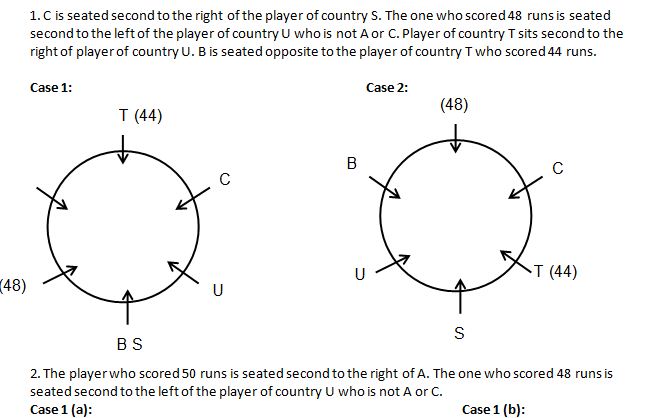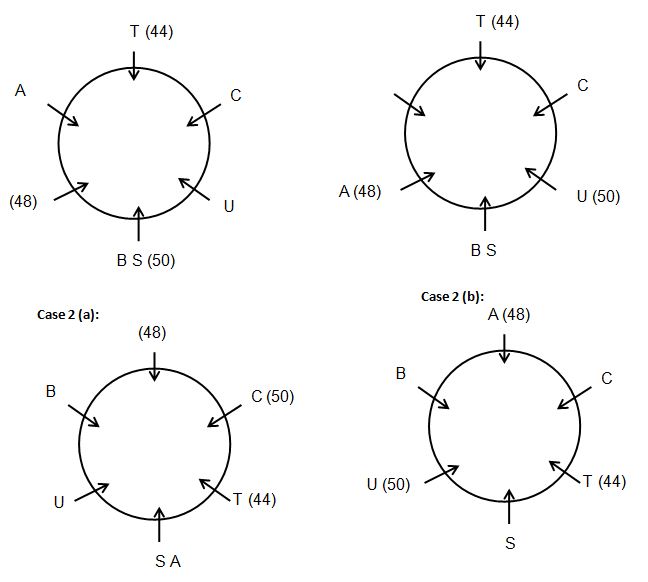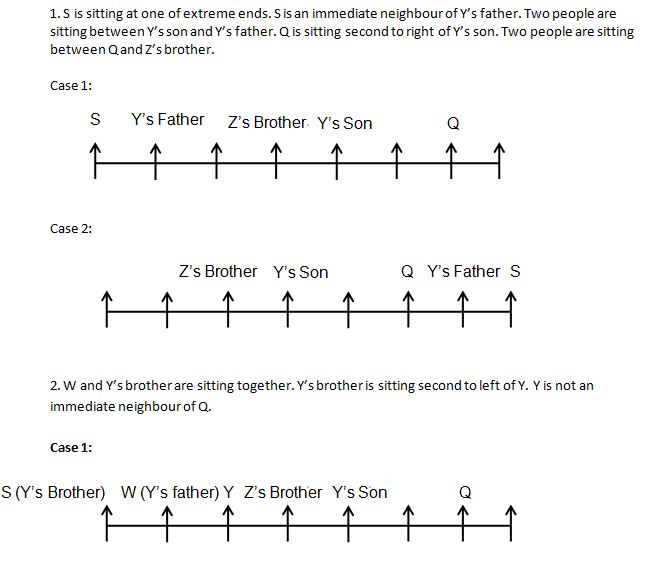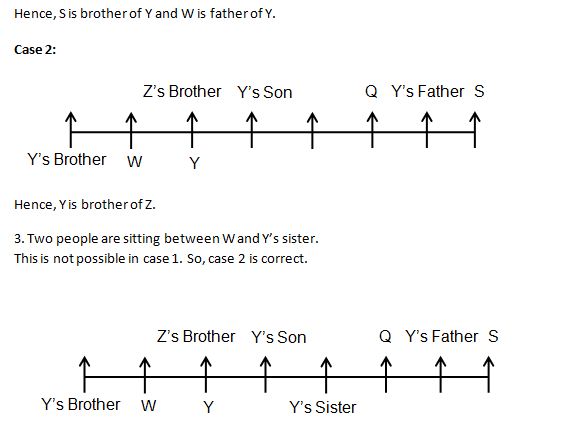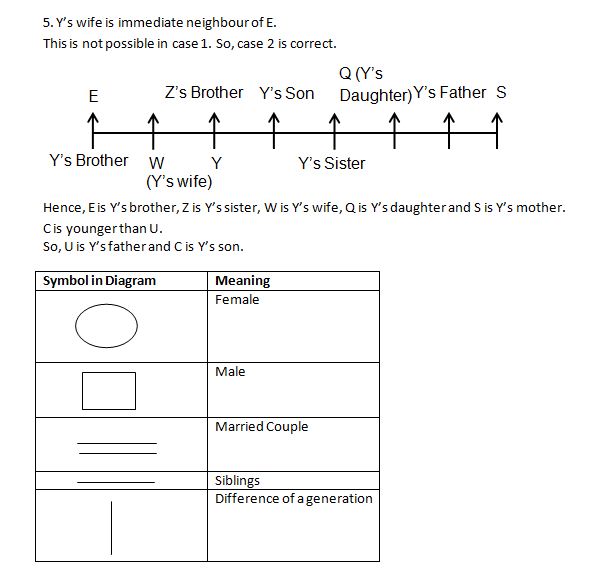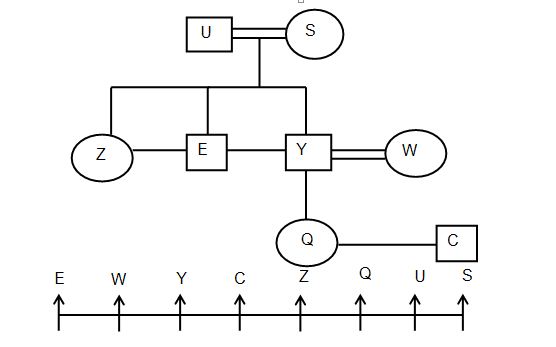Welcome to Online Reasoning Section with explanation in AffairsCloud.com. Here we are creating Best question samples from Puzzle with explanation, which is common for competitive exams. We have included Some questions that are asked in previous exams !!!
(Directions 1 – 5): Read the following information carefully and answer the questions given below it:
Six players A, B, C, D, E and F of six different countries P, Q, R, S, T and U are sitting around a circular table facing the centre. They all scored different runs in the match viz. 41, 44, 48, 50, 52 and 54 but not necessarily in the same order. C is seated second to the right of the player of country S. The one who scored 54 runs is not C. The one who scored 48 runs is seated second to the left of the player of country U who is not A or C. B is seated opposite to the player of country T who scored 44 runs. There is only one player between the player of country U and T but he is not from country P. Player of country T sits second to the right of player of country U. The player who scored 50 runs is seated second to the right of A. The player who scored 52 runs is not seated near to the one who scored 44 runs. F is seated immediately left of the player of country R but not near to A. The player of country P is not seated near to the player of country Q but immediate right of D.
- Who is sitting opposite to the player of country Q?
1) C
2) D
3) B
4) Player of country P
5) FAnswer : 4) Player of country P
Solution:
Players – A, B, C, D, E and F
Country – P, Q, R, S, T and U
Runs – 41, 44, 48, 50, 52 and 54



Hence, player of country P sits opposite to Q. - What is the position of the player who scored 41 runs with respect to the one who scored 48 runs?
1) Second to the right
2) Immediate right
3) Immediate left
4) Opposite
2) Second to the leftAnswer : 4) Opposite
Hence, the one who scored 41 runs sits opposite to the one who scored 48 runs. - Which of the following statement is true?
1) E is the player of country U
2) C is second to the right of B but not near to E
3) B scored 52 runs and near to C
4) Player of country R is opposite to player of country S
5) C scored 50 runsAnswer : 1) E is the player of country U
Hence, E is the player of country U is the correct statement. - Who among the following scored 41 runs?
1) D
2) C
3) A
4) B
5) EAnswer : 2) C
Hence, C scored 41 runs. - Who is sitting opposite to E?
1) Player of country R
2) The one who scored 41 runs
3) A
4) F
5) BAnswer : 1) Player of country R
Hence, player of country R sits opposite to E.
(Directions 6 – 10): Read the following information carefully and answer the questions given below it:
There are eight members Y, Z, U, W, Q, S, C and E. Each of them is related to Y in some way or the other and all of them have different chocolates among 20, 27, 33, 38, 40, 43, 45 and 50 but not necessarily in the same order and all are sitting in a straight line facing North.
Q is sitting second to right of Y’s son. Two people are sitting between Q and Z’s brother. Two people are sitting between Y’s son and Y’s father. S is an immediate neighbour of Y’s father. S is sitting at one of extreme ends. The sum of chocolates of C and Q is equal to sum of chocolates kept by W and E. One among the four have the highest number of chocolates and one among the four have the lowest number of chocolates. W and Y’s brother are sitting together. The difference between the chocolates of W and Z is equal to the difference between the chocolates of Q and U. Y’s brother is sitting second to left of Y. Two people are sitting between W and Y’s sister. Y is not an immediate neighbour of Q. C has more number of chocolates than Y but less than S. E’s father is sitting to the immediate right of Y’s daughter. Y’s wife is immediate neighbour of E. C is younger than U.
- Who among the following sits third to the left of C?
1) U
2) E
3) Z
4) Y
5) None of theseAnswer : 2) E
Solution:
Members – Y, Z, U, W, Q, S, C and E





According to the information given, relations of Y are father, mother, sister, brother, wife, son and daughter.
6. The sum of chocolates of C and Q is equal to sum of chocolates kept by W and E. One among the four have the highest number of chocolates and one among the four have the lowest number of chocolates. C has more number of chocolates than Y but less than S.Hence, C does not have the highest number of chocolates. If we assume chocolates of C be 20 and chocolates of Q be 50 then it does not follow the condition of sum of chocolates of C and Q is equal to sum of chocolates of W and E.
Therefore sum of chocolates of W and E is 50 + 20 = 70. Sum of chocolates of C and Q is 27 + 43 = 70.
S > C > Y. So, chocolates of C is 43, S is 45 and Q is 27.5. The difference between the chocolates of W and Z is equal to the difference between the chocolates of Q and U.
W – Z = Q – U
Chocolates of Q are 27.
Hence, U chocolates can be 33, 38 and 40.
Therefore, difference between chocolates of U and Q can be 6, 11 and 13.
Let marks of W be 20 then chocolates of T can be 33, 38 and 40.
Therefore, difference between chocolates of W and Z can be 13, 18 and 20.
Hence, chocolates of W is 20, E is 50, Z is 33 and U is 40.
Chocolates of Y is 38.
Hence, E sits third to the left of C. - How is S related to C?
1) Mother
2) Grandmother
3) Sister
4) Daughter
5) BrotherAnswer : 2) Grandmother
Hence, S is grandmother of C. - How many chocolates does Y have?
1) 33
2) 20
3) 40
4) 38
5) 43Answer : 4) 38
Hence, Y has 38 chocolates. - Who among the following is father of Y?
1) U
2) Z
3) W
4) E
5) QAnswer : 1) U
Hence, U is father of Y. - What is the sum of chocolates of C and W?
1) 88
2) 63
3) 70
4) 73
5) None of theseAnswer : 2) 63
Hence, sum of chocolates of C and W is 63.



